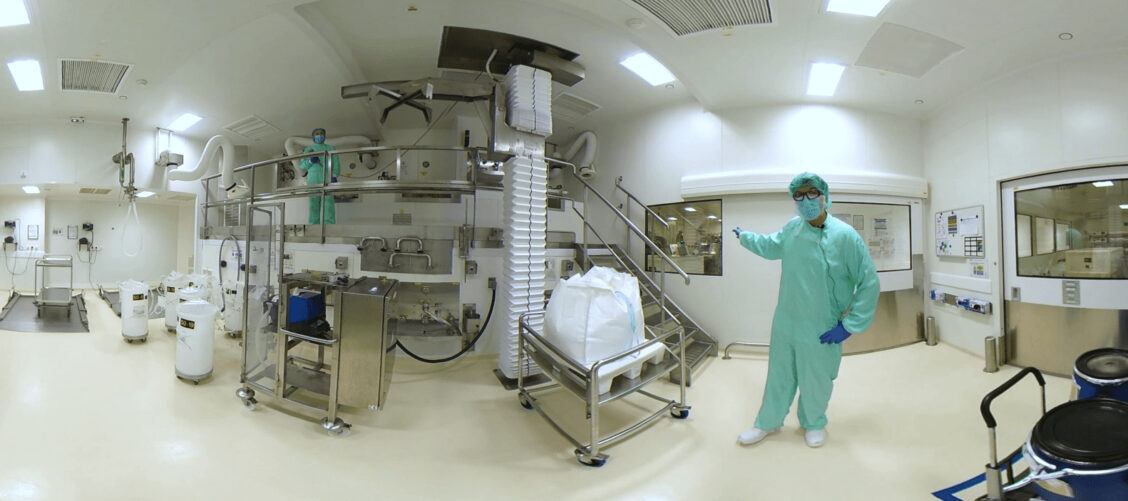Accelerating the skills development and performance of new operators
Speaker: Sebastien Fons, Innovation & HR Tools Manager
Authorization is a key step in the pharmaceutical industry. A technician cannot start working in the production area before completing it. It also requires the mobilization of industrial equipment and experienced personnel. In order to improve their authorization processes, with the objective of overcoming these issues, the LFB has integrated Virtual Reality.
Over the years, several use cases have emerged such as pre-employment training, centrifuge assembly and disassembly, dressing up to enter a high-risk area, and recruitment.

Results
« 90% of testers would not go back to in-person. Going through the VR headset is now routine. It has almost become normal and 80% of them want more immersive experiences. »
— Sebastien Fons, Responsable Innovation & Outils RH at LFB BIOMEDICAMENTS

LFB BIOMEDICAMENTS' numerous challenges
Making a technician autonomous
The challenge is to make a technician autonomous (authorized) to hold a workstation in order to ensure the proper functioning of the production line without:
- Incurring potential contamination risks
- Monopolizing equipment and experienced technicians
- Blocking production
Authorization, a critical step in the pharmaceutical industry:
« Authorization is an essential criterion to be able to carry out one's activity. When you hire someone, they cannot work until they are authorized. There is, therefore, a real challenge to mastering these training times, to reduce them if possible, not at the expense of quality, but really just to reduce downtime. »
— Sebastien, LFB BIOMEDICAMENTS
The procedure before integrating VR
- Monopolization of the premises for 1h30/participant
- Inconvenience for the technicians on their dispatching activities
- Risk of contamination of the airlocks (2 people, 1 of whom is not trained)
Easy handling, an accelerating engine for skills development.
There's a whole practical part that has to be done with an experienced tutor. This is a real challenge, since it requires the use of industrial equipment and an experienced technician, as well as having other impacts. « So, this is a real challenge, and Uptale has provided us with a solution. »
— Sebastien, LFB BIOMEDICAMENTS
Their use of VR in 2022
67%
vs. 25% on VR headset in 2021 (usage is increasing)
1,017
learning sessions
238
training hours
18
VR headsets, i.e. 3 suitcases of VR headsets were deployed at their various sites.
The results after deploying Uptale
- Time freed up for dispatchers
- Dressing demystified thanks to the VR approach
- Contamination control
- Technicians ready for hands-on practice
Other resources related to LFB Biomedicaments
FAQ
For on-the-job training experiences, how are quality teams involved in creating and validating content?
They are omnipresent. Moreover, it was one of the first constraints we had to overcome to bring equipment into a sterile zone. That’s why it took us time at the beginning because we had to find solutions with shells, etc., to get cameras in. We had many interdisciplinary preparatory meetings with production, quality to be as operational as possible.
They were, therefore, involved throughout the process. In terms of validation, they are present at every stage. At the beginning, they sometimes accompanied us during filming.
– Sebastien, LFB BIOMEDICAMENTS
How does it work with people who haven't necessarily grown up with digital technology?
What’s funny is that no one is used to it. Almost 100% of learners, regardless of their age or experience (it’s starting to become less true), used the headset for the first time.
The secret was to remove all the complexities that one can have in using a headset. The experience was already launched when the headset was put on, there was always someone to explain it to them, and the guardian had been designed in advance. We did everything we could so that when the learner used the headset, everything was almost okay. It’s a key to not having too much apprehension.
However, we cannot avoid dissatisfaction due to motion sickness, which we avoid by investing in better cameras and reducing it by the “static” nature of the experiences.
– Sebastien, LFB BIOMEDICAMENTS
Who identifies specific training needs and use cases? How do you identify them?
DFDI is a big customer in terms of identifying needs, so the School of Excellence in Training gives us a significant offering of training. We have enough to keep us busy!
Sometimes we have departments that contact us directly because they have thought of a use case, because they have been sensitized during the different open days we organize.
After that, we are also quite proactive regarding the strategy we want to put in place, the training challenges I described: everything related to authorization. It is the number one priority.
We also work with ancillary services because even internal communication is starting to solicit us for employer branding. It gives a modern image.
– Sebastien, LFB BIOMEDICAMENTS



